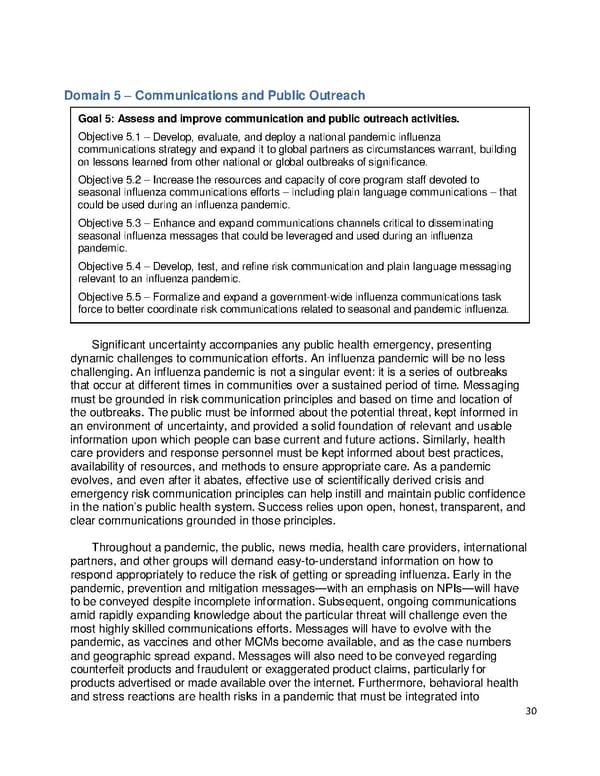Domain 5 – Communications and Public Outreach Goal 5: Assess and improve communication and public outreach activities. Objective 5 .1 – Develop, evaluate, and deploy a national pandemic influenza communications strategy and expand it to global partners as circumstances warrant, building on lessons learned from other national or global outbreaks of significance. Objective 5 .2 – Increase the resources and capacity of core program staff devoted to seasonal influenza communications efforts – including plain language communications – that could be used during an influenza pandemic. .3 – Enhance and expand communications channels critical to disseminating Objective 5 seasonal influenza messages that could be leveraged and used during an influenza pandemic. Objective 5 .4 – Develop, test, and refine risk communication and plain language messaging relevant to an influenza pandemic. Objective 5 .5 – Formalize and expand a government-wide influenza communications task force to better coordinate risk communications related to seasonal and pandemic influenza. Significant uncertainty accompanies any public health emergency, presenting dynamic challenges to communication efforts. An influenza pandemic will be no less challenging. An influenza pandemic is not a singular event: it is a series of outbreaks that occur at different times in communities over a sustained period of time. Messaging must be grounded in risk communication principles and based on time and location of the outbreaks. The public must be informed about the potential threat, kept informed in an environment of uncertainty, and provided a solid foundation of relevant and usable information upon which people can base current and future actions. Similarly, health care providers and response personnel must be kept informed about best practices, availability of resources, and methods to ensure appropriate care. As a pandemic evolves, and even after it abates, effective use of scientifically derived crisis and emergency risk communication principles can help instill and maintain public confidence in the nation’s public health system. Success relies upon open, honest, transparent, and clear communications grounded in those principles. Throughout a pandemic, the public, news media, health care providers, international partners, and other groups will demand easy-to-understand information on how to respond appropriately to reduce the risk of getting or spreading influenza. Early in the pandemic, prevention and mitigation messages—with an emphasis on NPIs—will have to be conveyed despite incomplete information. Subsequent, ongoing communications amid rapidly expanding knowledge about the particular threat will challenge even the most highly skilled communications efforts. Messages will have to evolve with the pandemic, as vaccines and other MCMs become available, and as the case numbers and geographic spread expand. Messages will also need to be conveyed regarding counterfeit products and fraudulent or exaggerated product claims, particularly for products advertised or made available over the internet. Furthermore, behavioral health and stress reactions are health risks in a pandemic that must be integrated into 30
 Pandemic Influenza Plan Page 29 Page 31
Pandemic Influenza Plan Page 29 Page 31